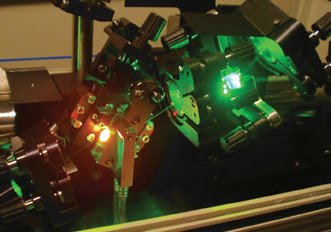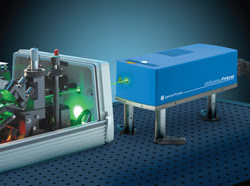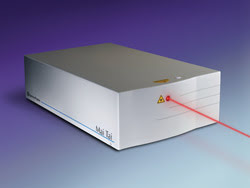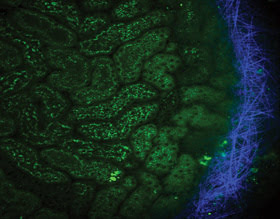From Research to Industry and Beyond
Julien Klein, Spectra-Physics
Since their invention
in the early 1980s, titanium-doped sapphire (Ti:Al2O3 or Ti:sapphire) lasers and
amplifiers have enabled countless applications in fundamental research in physics,
biology and chemistry. Today, they play an important role across a wide range of
photonics applications, including multicolor ultrafast spectroscopy, multiphoton
deep-tissue imaging, terawatt and petawatt physics, and “cold” micromachining.
The first reported Ti:sapphire laser operation was performed in
June 1982 by Peter Moulton at the 12th International Quantum Electronics Conference
in Munich, Germany.1 It was the first time Ti3+ was used as the active ion for laser
gain. In 1998, Spectra-Physics offered the first commercial Ti:sapphire laser, a
broadly tunable continuous-wave model and, in late 1990, the first ultrafast Ti:sapphire
laser, a picosecond mode-locked oscillator. Soon thereafter, the ultrafast and tunable
laser communities quickly replaced their cumbersome dye lasers with the popular
argon-ion-pumped Ti:sapphire systems, resulting in a sudden paradigm shift rarely
seen in research.

This Spectra-Physics Tsunami oscillator is being pumped
by a Millennia laser at 532 nm. Courtesy of Lund University in Sweden.
During their quick ascension in popularity, these laser systems
continued evolving with the introduction in the mid-1990s of tabletop commercial
amplified systems based on chirped pulse amplification techniques and, in 1996,
with the Millennia, a high-power diode-pumped solid-state (DPSS) 532-nm laser. The
use of DPSS lasers over argon-ion lasers as the pump significantly reduced the complexity
of ultrafast setups and drastically reduced the amplitude noise, a key improvement
for demanding femtosecond spectroscopy experiments.
Since then, a complete set of accessories has been developed to
support and complement Ti:sapphire lasers. Optical parametric oscillators and amplifiers
can extend wavelength tunability to access the deep-UV (<200 nm) and mid-IR regions
(>20 μm). Such spectrally agile tools have proved invaluable for multiwavelength
time-resolved spectroscopy.

Shown is a diode-pumped solid-state laser pumping an ultrafast Ti:sapphire laser.
Compared with other competing media, the Ti:sapphire medium is
extremely flexible and provides high performance and several advantages. It is unmatched
in its characteristics for delivering a combination of broad spectral bandwidth,
a range of repetition rates, wide tunability and high-average-power levels. Spectral
outputs of Ti:sapphire lasers range from ultranarrow single frequency to several
hundred nanometers of bandwidth, resulting in ultrafast pulses as short as a few
oscillations of the electric field at 5.5 fs. At the same time, repetition rates
can range from single-shot output for maximum energy up to multigigahertz quasi-CW
output with tunability of 400 nm and average powers of many watts.
As the push for even shorter, almost single-cycle pulses and high-precision
optical metrology gained momentum, an important development was the stabilization
of the carrier envelope phase (CEP), which paved the way for the generation of attosecond
(10–18 s) pulses in the x-ray spectrum through high-harmonic generation. Attosecond
laser sources are extending the frontier in probing dynamic molecular processes
with unprecedented time resolution.
CEP stabilization also plays a critical role in optical frequency
metrology, where an octave-spanning CEP-stabilized ultrafast oscillator can be used
as a frequency comb. Frequency combs are accurate “optical clocks” and
can measure optical frequencies with extraordinary precision. This work was honored
with the 2005 Nobel Prize in physics, which was awarded to Theodore W. Hänsch
and John L. Hall.
In chemistry, Ti:sapphire laser systems are used to study chemical
reactions on ultrafast time scales. Ahmed H. Zewail received the 1999 Nobel Prize
in chemistry for his pioneering work in the transition states of chemical reactions
using femtosecond spectroscopy. Recently, the field of coherent control has grown
increasingly sophisticated, and devices to control and measure the spectral phase
and amplitude of the ultrafast pulses have been developed.
In biology, Ti:sapphire lasers are instrumental in multiphoton
microscopy (MPM), which has developed into the leading noninvasive laboratory tool
for studying underlying biological phenomena. It offers high-resolution three-dimensional
imaging in thick tissues, including in vivo specimens. Because MPM inherently relies
upon a nonlinear process – two-photon absorption – it requires a high
peak power, which at first limited the practicality of MPM in the absence of easy-to-use,
tunable femtosecond lasers. The intensity of the laser required for an adequate
signal would have damaged the sample.

Pictured is the Mai Tai laser from Spectra-Physics.
However, a breakthrough occurred in 1990 when Winfried Denk, James
H. Strickler and Watt W. Webb used a femtosecond dye laser in the first successful
demonstration of MPM.2 Because of the combination of ultrashort pulses and low duty
cycle, these ultrafast lasers offered high peak powers with low average power –
the ideal combination because lower average powers eliminated thermal damage issues.
The lasers were cumbersome and difficult to maintain, and they required multiple
mirror sets and adjustments.
It was not until the recent advent of turnkey, hands-free, commercially
available, diode-pumped Ti:sapphire lasers such as the Spectra-Physics Mai Tai that
MPM became more practical. The extended tunability of these lasers has enabled the
use of various dyes with distinct absorption spectra and chemical properties. Because
in MPM the nonlinear signal is generated only in a small volume centered at the
focal point of a tightly focused beam, the “out-of-focus” signal is
greatly reduced compared with single-photon fluorescence microscopy – giving
MPM automatic sectioning capability for deep imaging of live tissue.

This image of a mouse kidney, in vivo, using second-harmonic generation (SHG)
imaging for collagen (blue) and autofluorescence signal (green), was taken using
a Spectra-Physics Mai Tai eHP DeepSee ultrafast laser. Courtesy of Dr. Claudio Vinegoni,
Center for Molecular Imaging Research at Massachusetts General Hospital, Harvard
University.
Additionally, the Ti:sapphire laser has been instrumental in fields
such as nonlinear physics and terahertz generation. It also is being used for cold
micromachining, where the cutting, drilling and scribing are free of undesirable
thermal effects.
Indeed, the Ti:sapphire is unsurpassed in its extraordinary breadth
of performance and resulting diversity of applications. In particular, its ability
to generate ultrafast pulses and wide wavelength tunability enable unprecedented
advances across a range of disciplines in science, industry and beyond.
Meet the author
Julien Klein is senior manager of product marketing at Spectra-Physics,
a Newport Corporation Brand in Santa Clara, Calif.; e-mail: [email protected].
References
1. P.F. Moulton (1986). Spectroscopic and laser characteristics
of Ti:A12O3. J. Opt. Soc. B, Vol. 3, p. 125.
2. W. Denk, J.H. Strickler and W.W. Webb (1990). Two-photon laser
scanning fluorescence microscopy, Science, Vol. 248, pp. 73-76.